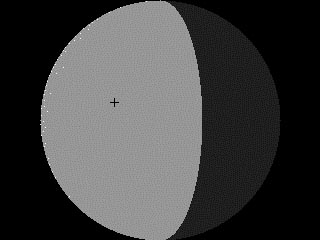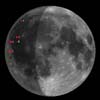|
Leonid MAC |
| home |
| View the shower |
| Mission Brief |
| Science Update |
| Media Brief |
| links |
LEONID DAILY NEWS: October 31, 2000
PROSPECTS FOR MOON IMPACT STUDIES Eight impact flashes of Leonid meteoroids hitting the Moon were recorded with CCD video cameras attached to small telescopes during the 1999 Leonid return. Luis Bellot Rubio, Jose Ortiz and Pedro Sada report in the upcoming special leonid issue of Earth, Moon and Planets that the biggest Leonid meteoroid hitting the Moon was about 5 kg in mass and created a new Moon crater of between 7 and 32 meter in diameter ( Full paper - PDF ). The impact positions are shown in the figure to the right. Moon impact enthusiasts will have a tough chase this year. The Moon will be positioned between Earth and the Leonid shower during the November 2000 encounter, as a result of which most Leonid meteoroid impacts will be on the back side of the Moon. The image left shows Moon impact predictions by Pete Gural of SAIC, with the white points representing the potential impact area for a uniformly random distribution of stream particles, the black cross is the radiant subpoint on the far side. The 2000 Leonids are most unfavorable with a few leakers over the northeast limb but unfortunately on the bright face for Nov 17. On Nov 18 the geometry is worse with the moon closer to the radiant with virtually no impacts visible on the sunward side. Even so, Moon impacts could prove the prize discovery of this year's Leonid season. There is a remote chance, that impacts on the North Pole of the Moon may provide further evidence for water ice in craters that are in eternal darkness. The Leonid meteoroids will impact the bottom of craters in that area at a grazing angle. This offers an opportunity to look for plumes containing water vapor. Of course, the probability of large impacts is remote and the plume of debris will have to rise high enough above the crater edge to be exposed by sunlight. Unlike impact flashes that last less than 1/30th of a second, plumes are formed more gradually and even imaging with regular astronomical CCD cameras on small telescopes may prove rewarding. David Asher of Armagh Observatory calculated that the Moon will cross the 1932 dust trail of comet Tempel-Tuttle around 5:00 UT on Nov. 17 at approximately only four Earth-diameters from the center of the dust trail. Oct. 31 - Prospects for Moon Impact Studies Oct. 30 - Comet dust crumbled less fine
| ||


 Figure left: White dots on a diagram of the Moon show where in 2000 Leonid meteoroid
impacts may be expected. Figure right: Location of impacts during the 1999 encounter.
Figure left: White dots on a diagram of the Moon show where in 2000 Leonid meteoroid
impacts may be expected. Figure right: Location of impacts during the 1999 encounter.
